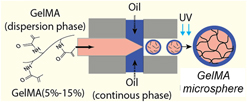Crossref Citations
This article has been cited by the following publications. This list is generated based on data provided by
Crossref.
Suvarnapathaki, Sanika
Nguyen, Michelle A.
Wu, Xinchen
Nukavarapu, Syam P.
and
Camci-Unal, Gulden
2019.
Synthesis and characterization of photocrosslinkable hydrogels from bovine skin gelatin.
RSC Advances,
Vol. 9,
Issue. 23,
p.
13016.
Suvarnapathaki, Sanika
Wu, Xinchen
Lantigua, Darlin
Nguyen, Michelle A.
and
Camci-Unal, Gulden
2019.
Breathing life into engineered tissues using oxygen-releasing biomaterials.
NPG Asia Materials,
Vol. 11,
Issue. 1,
Xie, Mingjun
Gao, Qing
Zhao, Haiming
Nie, Jing
Fu, Zhenliang
Wang, Haoxuan
Chen, Lulu
Shao, Lei
Fu, Jianzhong
Chen, Zichen
and
He, Yong
2019.
Electro‐Assisted Bioprinting of Low‐Concentration GelMA Microdroplets.
Small,
Vol. 15,
Issue. 4,
Jang, Kyoung-Je
Kim, Sujin
Park, Sangbae
Kim, Woochan
Gwon, Yonghyun
Park, Sunho
Lim, Ki-Taek
Seonwoo, Hoon
and
Kim, Jangho
2020.
Lithographically-Fabricated HA-Incorporated PCL Nanopatterned Patch for Tissue Engineering.
Applied Sciences,
Vol. 10,
Issue. 7,
p.
2398.
Jo, Yun Kee
and
Lee, Daeyeon
2020.
Biopolymer Microparticles Prepared by Microfluidics for Biomedical Applications.
Small,
Vol. 16,
Issue. 9,
Kupikowska-Stobba, Barbara
and
Lewińska, Dorota
2020.
Polymer microcapsules and microbeads as cell carriers forin vivobiomedical applications.
Biomaterials Science,
Vol. 8,
Issue. 6,
p.
1536.
Xu, Haibin
Sun, Miao
Wang, Chenggui
Xia, Kaishun
Xiao, Shining
Wang, Ye
Ying, Liwei
Yu, Chao
Yang, Quanming
He, Yong
Liu, An
and
Chen, Linwei
2020.
Growth differentiation factor-5–gelatin methacryloyl injectable microspheres laden with adipose-derived stem cells for repair of disc degeneration.
Biofabrication,
Vol. 13,
Issue. 1,
p.
015010.
Suvarnapathaki, Sanika
Wu, Xinchen
Lantigua, Darlin
Nguyen, Michelle A.
and
Camci‐Unal, Gulden
2020.
Hydroxyapatite‐Incorporated Composite Gels Improve Mechanical Properties and Bioactivity of Bone Scaffolds.
Macromolecular Bioscience,
Vol. 20,
Issue. 10,
Suvarnapathaki, Sanika
Nguyen, Michelle A.
Goulopoulos, Anastasia A.
Lantigua, Darlin
and
Camci-Unal, Gulden
2021.
Engineering calcium peroxide based oxygen generating scaffolds for tissue survival.
Biomaterials Science,
Vol. 9,
Issue. 7,
p.
2519.
Agarwal, Tarun
Kazemi, Sara
Costantini, Marco
Perfeito, Francisca
Correia, Clara R.
Gaspar, Vítor
Montazeri, Leila
De Maria, Carmelo
Mano, João F.
Vosough, Massoud
Makvandi, Pooyan
and
Maiti, Tapas Kumar
2021.
Oxygen releasing materials: Towards addressing the hypoxia-related issues in tissue engineering.
Materials Science and Engineering: C,
Vol. 122,
Issue. ,
p.
111896.
Savelyev, Alexander G.
Sochilina, Anastasia V.
Akasov, Roman A.
Mironov, Anton V.
Kapitannikova, Alina Yu.
Borodina, Tatiana N.
Sholina, Natalya V.
Khaydukov, Kirill V.
Zvyagin, Andrei V.
Generalova, Alla N.
and
Khaydukov, Evgeny V.
2021.
Facile Cell-Friendly Hollow-Core Fiber Diffusion-Limited Photofabrication.
Frontiers in Bioengineering and Biotechnology,
Vol. 9,
Issue. ,
Chen, Minjun
Bolognesi, Guido
and
Vladisavljević, Goran T.
2021.
Crosslinking Strategies for the Microfluidic Production of Microgels.
Molecules,
Vol. 26,
Issue. 12,
p.
3752.
Suvarnapathaki, Sanika
Wu, Xinchen
Zhang, Tengfei
Nguyen, Michelle A.
Goulopoulos, Anastasia A.
Wu, Bin
and
Camci-Unal, Gulden
2022.
Oxygen generating scaffolds regenerate critical size bone defects.
Bioactive Materials,
Vol. 13,
Issue. ,
p.
64.
Wei, Xiaowei
Shang, Yixuan
Zhu, Yefei
Gu, Zhuxiao
and
Zhang, Dagan
2023.
Encoding microcarriers for biomedicine.
Smart Medicine,
Vol. 2,
Issue. 1,
Zuo, Xiao
Jiang, Xia
Zhang, Yaya
Huang, Yushi
Wang, Ning
Zhu, Ping
and
Kang, Y James
2023.
A clinical feasible stem cell encapsulation ensures an improved wound healing.
Biomedical Materials,
Vol. 18,
Issue. 2,
p.
025005.
Lupachev, Egor V.
Voshkin, Andrey A.
Kisel’, Alexey V.
Kulov, Nikolai N.
Zakhodyaeva, Yulia A.
and
Polkovnichenko, Andrei V.
2023.
Separation of an Industrial Mixture of Decalin or Naphthalene Fluorination Products: Cis-Perfluorodecalin, Trans-Perfluorodecalin and Perfluoro(butylcyclohexane): Physicochemical, Thermophysical, and Spectral Data.
Processes,
Vol. 11,
Issue. 11,
p.
3208.
Tan, Jia
Li, Jiahui
and
Zhou, Xinli
2023.
Generation of cell-laden GelMA microspheres using microfluidic chip and its cryopreservation method.
Biomedical Materials,
Vol. 18,
Issue. 5,
p.
055023.
He, Dongliang
Wu, Zerui
Lin, Yao
Li, Guoyuan
Zhang, Zhanhao
Qiu, Yuheng
Ma, Yanan
Jia, Chengqi
Wei, Shan
Shang, Guangzhu
Lei, Xingyue
Hu, Peng
and
He, Liqun
2023.
Facile microfluidic device for droplets emulsion from small samples.
Journal of Flow Chemistry,
Vol. 13,
Issue. 1,
p.
53.
Ortega, Javiera Sanhueza
Corrales-Orovio, Rocío
Ralph, Peter
Egaña, José Tomás
and
Gentile, Carmine
2023.
Photosynthetic microorganisms for the oxygenation of advanced 3D bioprinted tissues.
Acta Biomaterialia,
Vol. 165,
Issue. ,
p.
180.
Zhao, Jiayi
Zhou, Chao
Xiao, Yang
Zhang, Kunyan
Zhang, Qiang
Xia, Linying
Jiang, Bo
Jiang, Chanyi
Ming, Wenyi
Zhang, Hengjian
Long, Hengguo
and
Liang, Wenqing
2024.
Oxygen generating biomaterials at the forefront of regenerative medicine: advances in bone regeneration.
Frontiers in Bioengineering and Biotechnology,
Vol. 12,
Issue. ,



